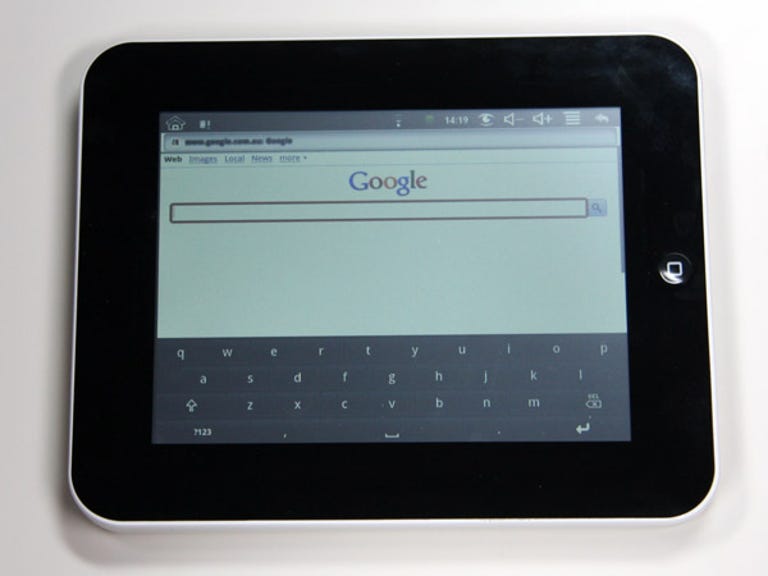 Why You Can Trust CNET
Why You Can Trust CNET Fake iPad (M-003) review: iPed M-003 (Fake iPad)
We would sooner recommend throwing wads of cash at unsuspecting passers-by than buying this fake iPad. Ironically, using this cut-price, wannabe iPad makes us want a real iPad. Or a netbook. Or something that works.
Editor's note: This device may or may not be available in Australia; our M-003 was purchased from a Shanghai market.
The Good
The Bad
The Bottom Line
Design
With its white shell and large screen this device could be the iPad that never was. Unfortunately, its plastic resistive screen with wavy edges, plastic body and 750RMB (AU$120) price tag mark it out as something inspired by the designers from Cupertino, California, but not actually from the house that Steve built.
The M-003, as its makers have dubbed it, stands 220mm tall, 180mm wide and 18mm thick. That makes it smaller, but fatter than the real thing. The differences in dimension come largely down to the smaller 7.9-inch screen — a real first-gen iPad has a 9.7-inch display. The fake iPad's display isn't only missing inches from its resume, it also does without the clarity, vibrancy and sheer number of pixels of the original — 800x600 versus 1024x768. There's an accelerometer on board to judge when the device is being held in landscape or portrait mode, but orientation switching is a lucky dip with long odds of success.
The resistive display requires a firm finger before the M-003 will register the user's intentions. Swiping motions are hard to convey, especially on screens — such as the applications tab — that are filled with buttons. Though the keys on the unit's virtual keyboard are quite large, typing is a laborious task for even the simplest of URLs with extreme care and lots of fingernail use the order of the day.
The required level of force and the frustrating number of errors makes using the M-003 an extremely tiring experience, both on one's patience and one's fingers. Given the difficulty operating the device with a single finger, it's almost a relief that it doesn't support multi-touch gestures, such as pinch to zoom.
One of the few plus points for the M-003 is its packaging. Despite the fact that it promises a real iPad, and the printing and image quality aren't up to scratch, it is significantly easier, with its side-hinged top, to open than the real iPad's box.
Features
The back of the fake iPad proudly boasts 64GB of storage, but unfortunately the reality is that the M-003 has between 1 and 1.5GB of usable space. This can be expanded via a microSD card or USB flash storage, the connectors for which lie along the bottom edge of the device. Unlike Apple's iPhone and iPad range, the file system is open to user exploration, both on the device itself or via a connected computer.
Also located along the bottom edge are a pair of speakers, a headphone jack and a power adapter. In the middle is a connector that looks suspiciously like Apple's iPod/iPhone/iPad connector, but isn't — it simply allows you to connect the M-003 to a PC. Confusingly, this connector has to be attached to the M-003 upside down, with the connector's marked side facing the floor, and there aren't any markings to show which side of the USB plug is up.
Without a SIM card slot, the M-003's only method of connecting to the internet is via its built-in Wi-Fi receiver.
Performance
The M-003's design failings may be the coffin in which this fake iPad lies, but its sluggish performance drives the nails in (slowly) and pours the concrete on.
To say that the fake iPad is seriously lacking grunt in the processing department is an understatement on par with, say, the United Arab Emirates having a little bit of oil. The M-003 takes 90 seconds to start up — that's more than triple the time a real iPad requires.
Even the smallest of applications take a while to load and page rendering on the Android web browser is sluggish. Video playback is a mess of artefacts and blockiness. Unfortunately, the only video we were able to play was the supplied sample, so we can't confirm whether this is the file's fault or the device's, although it's likely to be both.
Worse still the bottom half of the M-003 runs hot, even in standby mode. Consequently battery life is poor. On a full charge it lasts somewhere north of an hour of use, but on standby won't last the night. Plug the power in while the device is on and the M-003 quickly approaches scorching point.
Conclusion
We would sooner recommend throwing your wads of cash at unsuspecting passers-by than buying this fake iPad. Indeed, the irony of prolonged use of the M-003 is that we now want a real iPad. Or a netbook. Or a desktop. Or a smartphone. Indeed, any computing device that works as intended.


